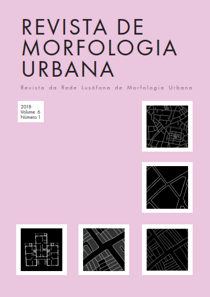Abstract
This paper, which is based on a chapter of a PhD thesis, is in two parts. The first part corresponds to the understanding of the notion of morphological processes, having as a guiding thread the work developed by M. R. G. Conzen, who considered the actions of transformation, addition, adaptation and stagnation. In the second part, motivated by the PhD research, attention is given to the process of stagnation with emphasis in the persistence of the urban elements, including studies of this nature on cities in Europe and Latin American as well as the case study developed in the thesis. The purpose of the bibliographical research was to collect theoretical and practical answers for the study of the persistence of the street, considering an ordinary, active city where the process of transformation is continuous, given by material, human or temporal action, without external interference of an exceptional nature.
References
Abreu, M. de A. (2012) Geografia histórica do Rio de Janeiro 1502-1700 (Andrea Jakobsson Estúdio, Rio de Janeiro).
Conzen, M. R. G. (1960) Alnwick, Northumberland: a study in town plan analysis, Institute of British Geographers Publication 27 (George Philip, Londres).
Conzen, M. R. G. (2004) Thinking about urban form: papers on urban morphology (1932-1998), M. P. Conzen (ed.) (Peter Lang Publishers, Nova Iorque).
Dias Coelho, C. (org.) (2013) Cadernos de morfologia urbana: os elementos urbanos (Argumentum, Lisboa).
Dias Coelho, C. (org.) (2014) Cadernos de morfologia urbana: o tempo e a forma (Argumentum, Lisboa).
Didi-Huberman, G. (2011) Sobrevivência dos vaga-lumes (Editora UFMG, Belo Horizonte).
Gonçalves, D. I. (1998) ‘O Peabiru: uma trilha indígena cruzando São Paulo’, Cadernos de Pesquisa do LAP-USP-FAU 24.
Grudet, I. (2007) ‘L'historien Pierre Lavedan et les transformations de l'urbanisme en France (1919-1955)’, Espaces et Sociétés 130, 41-55.
Holanda, S. B. de (1994[1957]) Caminhos e fronteiras (Companhia das Letras, São Paulo).
Holanda, S. B. de (2014[1945]) Capítulos da expansão paulista (Companhia das Letras, São Paulo).
Kostof, S. (1991-2009) The city shaped: urban patterns and meanings through History (Thames & Hudson, Londres).
Lavedan, P. (1926) Qu'est-ce que l’urbanisme? (Laurens, Paris).
Morris, A. E. J. (1979) Historia de la forma urbana (G. Gili, Barcelona).
Pereira Costa, S. A. e Gimmler Neto, M. M. (2015) Fundamentos de Morfologia Urbana (C/Arte, Belo Horizonte).
Pinon, P. (2008) ‘Défense et illustration de la loi de persistance du plan: le problème de la survivance du tracé des rues dans les villes françaises d’origine antique’, em Ballet, P., Dieudonné-Glad N. e Saliou, S. (org.) La rue dans l’Antiquité: définition, aménagement, devenir (Presses Universitaires de Rennes, Paris) 129-40.
Portas, N. (2005) Os tempos das formas: a cidade feita e refeita (Universidade do Minho, Guimarães).
Reis, N. G. (2014 [1970]) Quadro da arquitetura no Brasil (Perspectiva, São Paulo).
Reis, N. G. (2004) São Paulo: vila, cidade, metrópole (Ministério da Cultura, São Paulo).
Rocha Filho, G. N. da (1994) Os caminhos quinhentistas de São Paulo (http://historiadesaopaulo.com.br/) consultado em 10 agosto de 2017.
Waisman, M. (2013) O interior da história: historiografia arquitetônica para uso de latino-americanos (Perspectiva, São Paulo).
Os direitos autorais permanecem com os autores, que autorizam a Revista de Morfologia Urbana a publicar o artigo sob uma licença Creative Commons Atribuição (CC-By).


